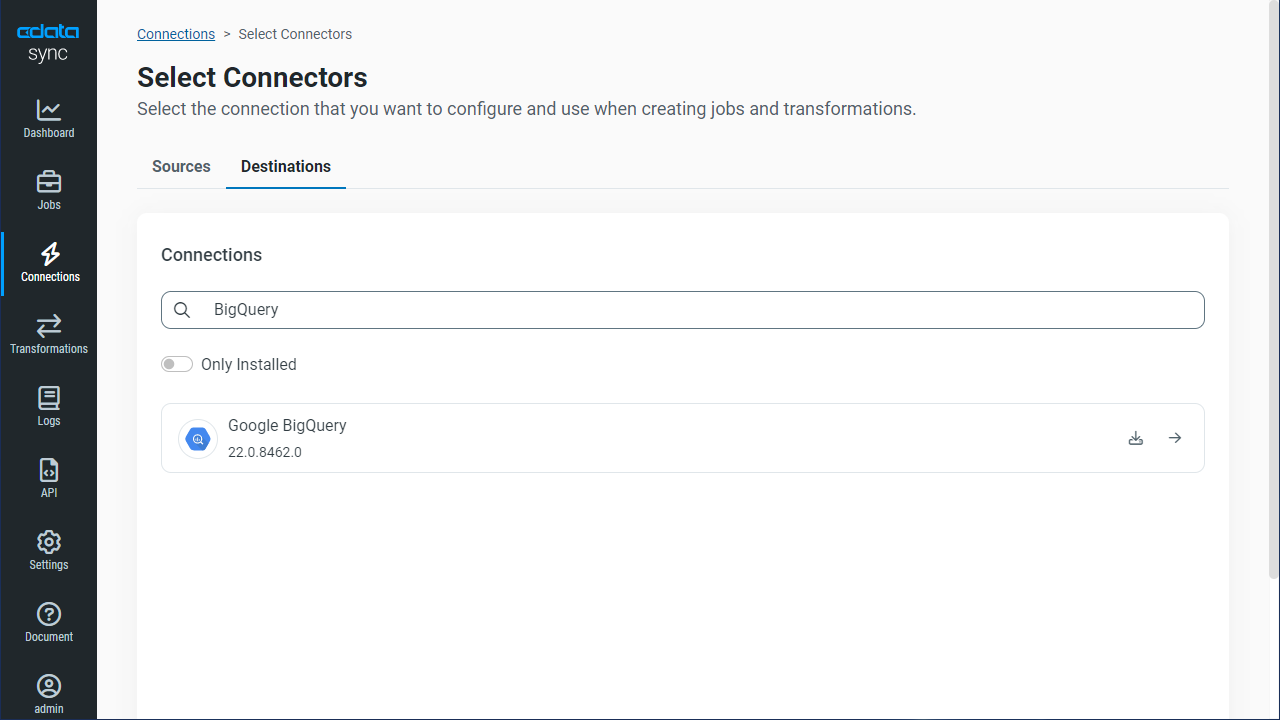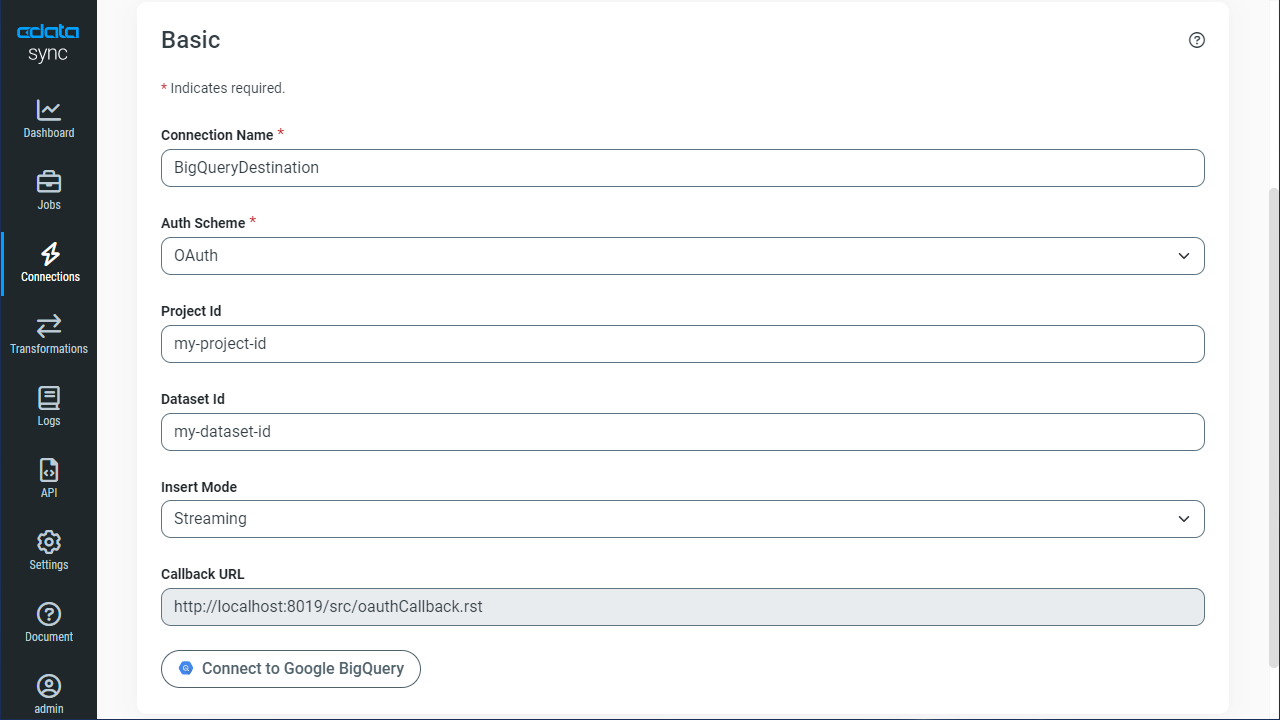Discover how a bimodal integration strategy can address the major data management challenges facing your organization today.
Get the Report →Automated Continuous SQL Analysis Services Replication to Google BigQuery
Use CData Sync for automated, continuous, customizable SQL Analysis Services replication to Google BigQuery.
Always-on applications rely on automatic failover capabilities and real-time data access. CData Sync integrates live SQL Analysis Services data into your Google BigQuery instance, allowing you to consolidate all of your data into a single location for archiving, reporting, analytics, machine learning, artificial intelligence and more.
Configure Google BigQuery as a Replication Destination
Using CData Sync, you can replicate SQL Analysis Services data to Google BigQuery. To add a replication destination, navigate to the Connections tab.
- Click Add Connection.
- Select Google BigQuery as a destination.
![Configure a Destination connection to Google BigQuery.]()
Enter the necessary connection properties. To connect to Google BigQuery, use OAuth authentication:
Authenticate with a User Account
In this OAuth flow, you can connect without setting any connection properties for your user credentials.
- Click Connect, and CData Sync opens the Google BigQuery OAuth endpoint.
- Log in and grant permissions to CData Sync.
- CData Sync then completes the OAuth process.
Authenticate with a Service Account
Service accounts have silent authentication, without user authentication in the browser. You can also use a service account to delegate enterprise-wide access scopes to CData Sync.
You need to create an OAuth application in this flow. See Creating a Custom OAuth App in the Getting Started section to create and authorize an app. You can then connect to Google BigQuery data that the service account has permission to access.
After setting the following connection properties, you are ready to connect:
- OAuthClientId: Set this to the Client ID in your app settings.
- OAuthClientSecret: Set this to the Client Secret in your app settings.
- OAuthJWTCertType: Set this to "PEMKEY_FILE".
- OAuthJWTCert: Set this to the path to the .pem file you generated.
- OAuthJWTCertPassword: Set this to the password of the .pem file.
- OAuthJWTCertSubject: Set this to "*" to pick the first certificate in the certificate store.
- OAuthJWTSubject: Set this to the email address of the user for whom the application is requesting delegate access. Note that delegate access must be granted by an administrator.
- DatasetId: Set this to the ID of the dataset you want to connect to.
- ProjectId: Set this to the ID of the project you want to connect to.
- Click Test Connection to ensure that the connection is configured properly.
![Configure a Destination connection.]()
- Click Save Changes.
Configure the SQL Analysis Services Connection
You can configure a connection to SQL Analysis Services from the Connections tab. To add a connection to your SQL Analysis Services account, navigate to the Connections tab.
- Click Add Connection.
- Select a source (SQL Analysis Services).
- Configure the connection properties.
To connect, provide authentication and set the Url property to a valid SQL Server Analysis Services endpoint. You can connect to SQL Server Analysis Services instances hosted over HTTP with XMLA access. See the Microsoft documentation to configure HTTP access to SQL Server Analysis Services.
To secure connections and authenticate, set the corresponding connection properties, below. The data provider supports the major authentication schemes, including HTTP and Windows, as well as SSL/TLS.
-
HTTP Authentication
Set AuthScheme to "Basic" or "Digest" and set User and Password. Specify other authentication values in CustomHeaders.
-
Windows (NTLM)
Set the Windows User and Password and set AuthScheme to "NTLM".
-
Kerberos and Kerberos Delegation
To authenticate with Kerberos, set AuthScheme to NEGOTIATE. To use Kerberos delegation, set AuthScheme to KERBEROSDELEGATION. If needed, provide the User, Password, and KerberosSPN. By default, the data provider attempts to communicate with the SPN at the specified Url.
-
SSL/TLS:
By default, the data provider attempts to negotiate SSL/TLS by checking the server's certificate against the system's trusted certificate store. To specify another certificate, see the SSLServerCert property for the available formats.
You can then access any cube as a relational table: When you connect the data provider retrieves SSAS metadata and dynamically updates the table schemas. Instead of retrieving metadata every connection, you can set the CacheLocation property to automatically cache to a simple file-based store.
See the Getting Started section of the CData documentation, under Retrieving Analysis Services Data, to execute SQL-92 queries to the cubes.
![Configure a Source connection (Salesforce is shown).]()
-
HTTP Authentication
- Click Connect to ensure that the connection is configured properly.
- Click Save Changes.
Configure Replication Queries
CData Sync enables you to control replication with a point-and-click interface and with SQL queries. For each replication you wish to configure, navigate to the Jobs tab and click Add Job. Select the Source and Destination for your replication.

Replicate Entire Tables
To replicate an entire table, click Add Tables in the Tables section, choose the table(s) you wish to replicate, and click Add Selected Tables.

Customize Your Replication
You can use the Columns and Query tabs of a task to customize your replication. The Columns tab allows you to specify which columns to replicate, rename the columns at the destination, and even perform operations on the source data before replicating. The Query tab allows you to add filters, grouping, and sorting to the replication.
Schedule Your Replication
In the Schedule section, you can schedule a job to run automatically, configuring the job to run after specified intervals ranging from once every 10 minutes to once every month.

Once you have configured the replication job, click Save Changes. You can configure any number of jobs to manage the replication of your SQL Analysis Services data to Google BigQuery.










